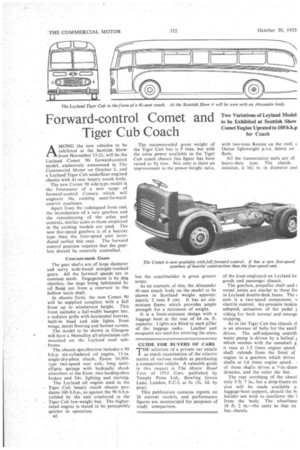Forward-control Comet and Tiger Cub Coach
Page 36

If you've noticed an error in this article please click here to report it so we can fix it.
AMONG the new vehicles to be exhibited at the Scottish Show from November 13-21, will be the Leyland Comet 90 forward-control model, exclusively announced in The Commercial Motor on October 2, and a Leyland Tiger Cub underfloor-engined chassis with 41-seat luxury coach body.
The new Comet 90 side-type model is the forerunner of a new range of forward-control Comets which will augment the existing semi-forwardcontrol machines.
Apart from the redesigned front end, the introduction of a new gearbox and the repositioning of the axles and controls, similar units to those employed in the existing models are used. The new five-speed gearbox is of a heavier type than the four-speed unit introduced earlier, this year. The forward control position requires that the gearbox should be remotely controlled.
Constant-mesh Gears The gear shafts are of large diameter and carry wide-faced straight-toothed gears, All the forward speeds are in constant mesh. Engagement is by dog clutches, the dogs being lubricated by oil flung out from a reservoir in the hollow main shaft.
In chassis form, the new Comet 90 will be supplied complete with a full front up to windscreen height. This front includes a full-width bumper bar, a radiator grille with horizontal louvres, built-in head and side lights, front wings, metal flooring and bonnet covers.
The model to be shown in Glasgow will have a Homalloy all-aluminium cab mounted on the Leyland steel subframe.
The chassis specification includes a 90 b.h.p. six-cylindered oil engine, 13-in. single-dry-plate clutch, Eaton 16,5C0type two-speed rear axle, long semielliptic springs with hydraulic shock absorbers at the front, two-leading-shoe brakes and 24v. lighting and starting.
The Leyland oil engine used in the Tiger Cub luxury coach chassis produces 100 b.h.p., as against the 90 b.h.p. yielded by the unit employed in the Tiger Cub low-weight bus. The higherrated engine is stated to be perceptibly quieter in operation.
s2 The recommended gross weight of the Tiger Cub bus is 9 tons, but with the extra power available in the Tiger Cub coach chassis this figure has been raised to 9i tons. Not only is there an improvement in the power-weight ratio, but the coachbuilder is given greater scope.
As an example of this, the Alexander 41-seat coach body on the model to be shown in Scotland weighs approximately 2 tons 8 cwt. It has an aluminium frame which provides ample strength for a minimum of weight.
It is a front-entrance design with a luggage boot at the rear of 64 cu. ft. capacity. Lights are fitted to each pillar of the luggage racks. Leather and moquette are used for covering the seats, with two-tone Rexine on the roof, a Dulon lightweight p.v.c. fabric on floor.
All the transmission units are of heavy-duty type. The clutch, instance, is 161 in. in diameter and
of the kind employed on Leyland he goods and passenger chassis.
The gearbox, propeller shaft and t versa' joints are similar to those foi in Leyland double-deck buses. The] axle is a two-speed component, v electric control. Air-pressure brakin adopted, actuation of the pedal viding for both normal and emerge stopping.
As in the Tiger Cub bus chassis, ti is an absence of belts for the auxil drives. The self-adjusting centrift water pump is driven by a helical j which meshes with the camshaft g it runs at 1.5 times engine speed. shaft extends from the front of engine to a gearbox which drives shafts at 1.6 times engine speed. of these shafts drives a 7-in.-diam dynamo, and the other the fan.
The rear overhang of the chassi only 3 ft. 7 in, but a drop-frame ex sion will be made available a luggage-boot support, should the In builder not wish to cantilever the from the body. The wheelbase 16 ft. 2 in.—the same as that on bus chassis.




















































































